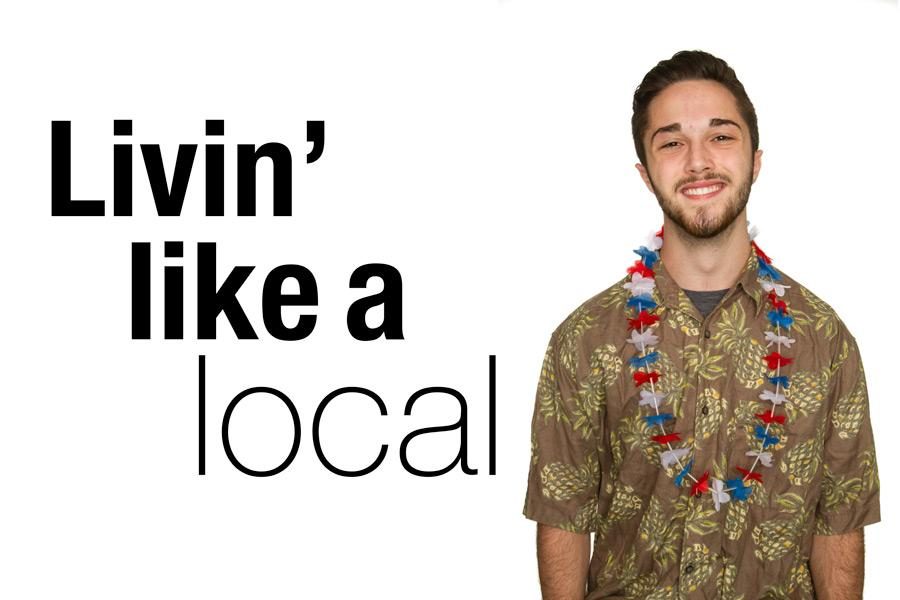Livin’ like a local
Junior reflects on trip to Hawaii
Photo by Madeline Parish
October 7, 2015
As I stepped off the plane and into Kahului Airport, the sweet scent of Hawaiian pineapple filled the air around me. Swathes of fellow tourists rushed past me in desperate attempts to reach baggage claim before everyone else. Mild airport anxiety had set in, but once in the car was en route to the apartment, relaxing came easy. This was vacation, but it didn’t feel like it. Instead, I was to make Hawaii my home for the next two weeks.
Hawaiian life is much like you’d expect: palm trees, pineapples and bungalows made of a variety of local materials. Looking around, you really start to question whether or not you’re still in the same country. Sure, you have your Starbucks and McDonald’s, but with the wide variety of local foods priced roughly the same as a Quarter Pounder, seared mahi becomes the favorable choice.
In fact, with such an expansive variety of foods, it becomes a bit overwhelming. One of the island’s many renowned establishments, Maui Brewing Company, is famous for their draft beers and fine foods. Their wide open seating and mellowed out, sports-centered atmosphere made for an eating experience that was unique and individual– even for a brewery.
Each Mauian town has its own cultural personality. Paia is a hippy town: organic food markets and restaurants line the streets like liquor stores to State Line, an award-winning fish market lies at its heart and local Hawaiian art of all forms is displayed in windows.
Lahaina is surfer’s paradise: brand names and board shops such as Vans and Billabong clutter Main Street, which sits only a few feet from the beach.
Hana embodies the Hawaiian native: secluded, simple and largely unpretentious. Each town has its own flair to bring to the island culture.
Formality is all but absent in the chilled-out surfer dialect, but in a way that makes chatting with the locals a casual affair. The east end of the island hosted a more native crowd, of whom spoke in an almost incoherent slang, and their unwelcoming scowls signaled an overall distaste for tourists.
In more secluded areas, such as the coastal town of Hana, locals attempt to scare off tourists from admittedly more dangerous areas by placing skulls and bones of various animals along the highways, but for good reason. These areas are best left to the people who know them through and through.
The Hawaiian people themselves are some of the most relaxed you’ll ever meet. Secular issues such as politics seemed absent from mind in Maui. The liberal mindset doesn’t allow for any interfering on the well-being of others. Instead, focus is placed more on the spiritual and physical well-being of the self, which makes for a crowd so down to earth you stop and question your own motives in life. The way of life doesn’t allow judgement; You view people as just another situation, someone with a history and a story to tell.
Health bars and yoga centers don’t cover the island for the same reasons they might elsewhere. They exist because the culture drives a demand for places centered around self-betterment with meaningful experiences. The people you meet day-to-day are memorable because their intent isn’t profit. They view you not as a customer, but as another human being. And while that may seem like an “across the board” mindset, you’ll find yourself craving the profoundness of the relationships you form with ordinary people when it’s all said and done.
Some of Hawaii’s most incredible landscapes are easily some of the most dangerous. Most of the topography sits well above sea level, so outlooks and vistas, with their makeshift advisory signs and burial grounds, warn of danger. The Road to Hana featured roads most wouldn’t even think of driving; Any vehicle larger than a pickup truck was asking for trouble. Furthermore, blowholes, vacuum-like holes in the rocky earth where the ocean breeze shoots water well above the surface, have been known to suck people in, leading to an abrupt and frightening death.
High above the clouds, the terrain is rocky and jagged, especially on Mount Haleakala, Hawaii’s only active volcano. Its peak sits at a cool 10,023 feet and the view is unlike any other, but so is the danger. Some drops would give you enough time to really come to terms with the fact that you’ll have a very sticky end. But of course, if you’re smart enough to stay humble, you’ll leave with pictures that seem too amazing to be real.
Hawaii has offered an experience that not many can say they’ve had. It’s truly a masterpiece of mother nature, and its distinct culture and history make it a place unlike any other on Earth. The privilege of having the opportunity to truly live like a local is one that allowed me to experience Hawaii and what it has to offer without the filter of luxuries and accommodations of a resort and the typical vacation setting. It’s easy to see why the spirit of Aloha is so heavily embodied in Hawaiian culture. It’s not just a friendly “hello” or “goodbye,” it’s the welcoming embrace of a culture open to all others.
















